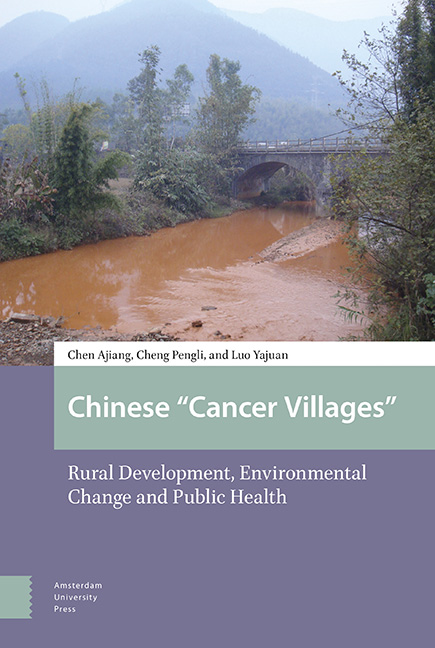Book contents
- Frontmatter
- Contents
- List of Figures, Graphs and Tables
- Acknowledgements
- Preface to the English Language Edition
- 1 Retrospective Thoughts on the ‘Cancer Village’ Phenomenon
- 2 The Ins and Outs of a ‘Cancer Village’
- 3 A Subei ‘Cancer Village’
- 4 Environmental Change and Health Risks
- 5 A Prosperous ‘Cancer Village’
- 6 Coexistence of Poverty and Cancer
- 7 Problematization and De-stigmatization
- 8 Behind the ‘High Incidence of Lung Cancer’
- 9 Villagers’ Perceptions of and Responses to the Relationship between Cancer and Pollution
- 10 Villagers Strategies for Mitigating Environmental Health Risks
- Index
- Index (Chinese) 中文索引
3 - A Subei ‘Cancer Village’
Published online by Cambridge University Press: 20 November 2020
- Frontmatter
- Contents
- List of Figures, Graphs and Tables
- Acknowledgements
- Preface to the English Language Edition
- 1 Retrospective Thoughts on the ‘Cancer Village’ Phenomenon
- 2 The Ins and Outs of a ‘Cancer Village’
- 3 A Subei ‘Cancer Village’
- 4 Environmental Change and Health Risks
- 5 A Prosperous ‘Cancer Village’
- 6 Coexistence of Poverty and Cancer
- 7 Problematization and De-stigmatization
- 8 Behind the ‘High Incidence of Lung Cancer’
- 9 Villagers’ Perceptions of and Responses to the Relationship between Cancer and Pollution
- 10 Villagers Strategies for Mitigating Environmental Health Risks
- Index
- Index (Chinese) 中文索引
Summary
Abstract
From 2000, local governments actively recruited polluting industries to move into rural areas of Northern Jiangsu (Subei). This chapter analyses the case of Dongjing Village. It describes the actual situation regarding industrial pollution, the interests and choices of the local government, the villagers’ resistance, the actions and limitations of the media, and the disconnect between environmental law and the actual handling of conflicts over pollution. The research found that the attitude and actions of the government showed a tendency towards post hoc crisis management. But the problem of industrial pollution is difficult to solve, and the appearance of ‘cancer villages’ during this period was related to factors including the cadre evaluation system, the structure of power and interest relations, and the lack of independence of administrative agencies.
Keywords: chemical industry, high incidence of cancer, catch-up modernization, environment and health, media, environmental law
Introduction
The term ‘Subei’ has referred to different geographical areas in different historical periods. Right after the establishment of the People's Republic of China (PRC), ‘Subei’ referred to an administrative area under the ‘Subei People's Administrative Office’ which was established in Taizhou City on 21 April 1949. The Subei Office administered five cities – Taizhou, Yangzhou, Yancheng, Huaiyin and Nantong – as administrative divisions. In January 1950, the Subei Administrative Office decided to combine the Yangzhou and Taizhou administrative divisions,and named them the Taizhou Administrative Area. The Subei Administrative Office was then relocated from Taizhou to Yangzhou. In April of the same year, it was renamed the Jiangsu Province Subei Administrative Office. In November 1952, the Subei administrative area, the Sunan administrative area, and the city of Nanjing joined to form Jiangsu Province. In early 1984, based on research in the small towns of Jiangsu, Fei Xiaotong suggested replacing the traditional two-way division into Sunan and Subei with a three-way division of Jiangsu Province into three areas: Sunan, Suzhong and Subei. Sunnan includes the three cities of Suzhou, Wuxi and Changzhou, and the eastern and southern parts of Nantong city; Suzhong includes part of Yangzhou City along the Yangtze River, Zhenjiang, Nanjing, and the western and northern parts of Nantong City; and Subei includes Xuzhou, Lianyungang, Yancheng, Huaiyin, and part of Yangzhou City.
- Type
- Chapter
- Information
- 'Chinese Cancer Villages'Rural Development, Environmental Change and Public Health, pp. 85 - 124Publisher: Amsterdam University PressPrint publication year: 2020

